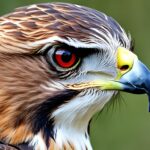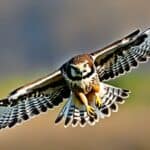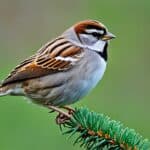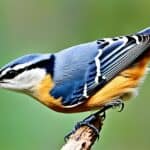Have you ever spotted a hawk up in the sky and wondered what kind it was? It might seem hard to tell one hawk from another at first. Yet, with some observation, you’ll start to notice distinct features, actions, and where they live. This will make hawk identification much easier.
America is home to many hawks, each with its unique way of life. Some, like the buteos, love open spaces and fly high above the ground. Others, such as the accipiters, prefer the cover of trees and are quick flyers. You might find it tricky to tell them apart because of changes in their feathers as they grow and differences in their looks. But watching how they fly, listening to their calls, and knowing where they usually are can give you clues.
This guide aims to help you understand more about hawk species, making watching them fun and interesting. Let’s explore the wonderful world of American hawks together.
Characteristics of Accipiters in the USA
In the USA, accipiters are a distinctive group of hawks. They’re known for their great skills in dense forests. Their swift flight helps them move between trees easily when hunting. Knowing about accipiters helps in identifying hawks by what they look like and how they act.
Sharp-shinned Hawk
The Sharp-shinned Hawk is the smallest accipiter. It has a slim body and short, rounded wings. It flies quickly and easily through forests. Look for its short, square tail with a narrow white tip. It catches small birds by surprise.
Cooper’s Hawk
Cooper’s Hawk is a bit bigger than the Sharp-shinned. It’s strong and has a longer, rounded tail. It hunts medium-sized birds and small mammals well. You can spot it by its blue-gray back and fierce eyes.
Northern Goshawk
The Northern Goshawk is the biggest accipiter. It has large wings and a long, white-tipped tail. It’s very skilled in forests. Look for its slate-gray back and white eyebrow stripe.
Knowing the differences between these accipiters is key to understanding hawks. It also helps you admire their unique abilities in nature.
Types of Buteos Found in the USA
Buteos are a wide variety of hawks known for their wide wings and strong bodies. They are great at flying without much effort. These birds like to live in places with lots of room for hunting. You can tell them apart by their size and markings.
Common Black Hawk
You can easily spot the Common Black Hawk in the southwest USA. It has dark feathers and broad wings. These hawks love areas near water and use their sharp eyes to hunt. Look at how they fly and where they hang out to know it’s them.
Red-tailed Hawk
The Red-tailed Hawk is all over North America, known for its red tail and wide wings. It can live in deserts, grasslands, and even forests. Its big size and noticeable tail help people figure out what kind of hawk it is.
Ferruginous Hawk
The Ferruginous Hawk is the biggest of the buteos in North America. It has white and rust feathers. These hawks like dry areas and grasslands, hunting from high spots or in the air. Their size and colors make them easy to spot.
Red-shouldered Hawk
Red-shouldered Hawks live in forests in the east and by the sea in the US. They have red shoulders and striped tails. They’re different from most other hawks because they like forests and hunt from the trees.
| Hawk Species | Distinct Features | Preferred Habitat | Behavior |
|---|---|---|---|
| Common Black Hawk | Dark plumage, broad wings | Riparian zones | Soaring |
| Red-tailed Hawk | Red tail, broad wings | Deserts, grasslands, forests | Adaptable, soaring |
| Ferruginous Hawk | White and rust-colored feathers | Arid regions, grasslands | High perches, soaring |
| Red-shouldered Hawk | Reddish shoulders, banded tail | Mixed woodlands | Agility, perching |
Identifying Kites in the USA
Getting into birdwatching introduces you to the world of kites, a raptor type. Learning to spot them is both fun and tough. American kites are known for their smooth wings and how they fly. They are smaller than some other raptors. But they move in a more skilled, ballet-like way.
You often see these kites floating or soaring as they look for food. People watching out for hawks notice kites by their special wings and light build. They’re also easy to spot because of where they browse for food. Kites mainly like places like swamps and big open lands.
Noticing how kites glide helps with telling them apart. Their floating flight shows off graceful moves up high and drop-downs. This is unlike the straight, strong flight big hawks do. Learning to not miss these features can make you a better kite-finder. And it lets you admire these fascinating birds even more.
Seasonal Range and Habitat
Hawks’ seasonal range and habitat preferences help us find them. Many hawks move from one place to another at different times. Knowing where they go during breeding and non-breeding seasons can tell us what hawks are near us.
Learning about hawks’ migration patterns makes birding more fun. It shows how these impressive predatory birds adapt to change. Watching a Red-tailed Hawk travel great distances or a Sharp-shinned Hawk go on its journey gives us a lot of information.
The type of place each hawk likes is very important. Some prefer open areas, while others like dense forests. These places not only affect how they act but also help us know who they are. Understanding the link between hawks and their favored habitats deepens our view of these amazing birds.
Differences Between Juvenile and Adult Hawks
Recognizing hawks can be tricky due to their changing features as they grow. It’s important to notice these differences. This helps you identify them accurately.
Plumage
One big difference is in their feathers or plumage. Young hawks have feathers that are more mixed or spotted. Adults have smooth, distinct feathers. The change in color and pattern is a key part of their growth.
Size and Shape
Juvenile hawks can seem bigger or clumsier than sleek adults. This difference is useful for spotting hawks. It gives you more clues about their age.
Behavioral Traits
The way they act is also different. Young hawks might fly unpredictably and hunt clumsily. Adults are much better at flying and hunting. Watching their behavior tells us more about their age.
| Juvenile Hawks | Adult Raptors |
|---|---|
| Mottled/Streaked Plumage | Defined Coloration |
| Larger or Gangly Size | Slim, Streamlined Appearance |
| Erratic Flight, Less Refined Hunting | Experienced Flight and Hunting Techniques |
Flight Patterns and Techniques
Hawks have unique ways of flying and hunting. It’s key to know these to correctly name the hawk you see. Each kind of hawk flies differently and hunts in specialized ways, all influenced by their home. This info is golden for those who enjoy spotting and identifying birds out in the world.
Soaring Techniques
Soaring is a big thing for hawks. Buteos often spiral upwards on warm air currents, saving their energy. This high aerial view helps them spot prey. Accipiters are different; they mainly fly fast through trees and bushes, using their quick wings and sharp eyes to find food.
Hunting Styles
Hawks hunt in many ways. The Peregrine Falcon is a master of the high-speed dive, grabbing its meal in the air. But, the Harris’s Hawk is clever, working together in hunting groups. Knowing these tactics helps classify hawks better and makes bird watching more rewarding.
| Hawk Species | Flight Pattern | Hunting Technique |
|---|---|---|
| Buteos | Circular soaring in thermal updrafts | Surveying from high perches or soaring |
| Accipiters | Flapping and gliding through forests | Ambush hunting within dense cover |
| Peregrine Falcon | High-speed stoops | Direct aerial strikes on flying prey |
| Harris’s Hawk | Coordinated group maneuvers | Team-based hunting tactics |
Vocalizations and Calls of Hawks
Learning hawk calls can make birdwatching better. You can spot different hawk species by their special raptor vocalizations. This makes identifying these amazing birds easier.
Accipiter Calls
Accipiters like Sharp-shinned Hawks and Cooper’s Hawks make sharp, fast sounds. Their high-pitched, repeat sounds fill dense forests. Knowing these unique raptor vocalizations helps find accipiters when they are hard to see.
Buteo Calls
Red-tailed Hawks and Red-shouldered Hawks scream clearly and loudly. Their hawk calls are for wide-open areas. This makes them stand out and easier to notice while birdwatching.
| Species | Habitat | Call Description |
|---|---|---|
| Sharp-shinned Hawk | Dense Forests | Sharp, rapid calls |
| Cooper’s Hawk | Wooded Areas | High-pitched, repetitive sounds |
| Red-tailed Hawk | Open Spaces | Clear, piercing cries |
| Red-shouldered Hawk | Mixed Forests | Loud, carrying calls |
How do you identify different types of hawks in the USA?
Identifying different hawks in the USA is rewarding with a good hawk identification guide. Start by looking at their physical traits like wing shape and plumage. It’s key to also watch how they act. For instance, hawks flying high might be different than those darting through forests.
Hawks in the U.S. live in different spots. Buteos, with their wide wings, hunt in the open skies. Accipiters thrive in forests, using their nimbleness to chase prey. Knowing how they fly is crucial for telling them apart.
Hawks also sound different, which helps in identification. Buteos have loud, clear calls while accipiters’ notes are quick and sharp. Pairing sounds with sights makes spotting them more exact.
Migratory habits change how hawks are seen throughout the year. They behave differently in mating and non-mating seasons. Knowing these movements helps identify them at any time.
“By thoroughly studying the habitats, behaviors, and physical attributes of hawks, bird enthusiasts can become adept at identifying the diverse species that inhabit the USA.”
| Factor | Description |
|---|---|
| Physical Characteristics | Size, wing shape, and plumage patterns |
| Behavioral Cues | Flight patterns, hunting styles, and vocalizations |
| Habitats | From open fields to dense forests, habitat preferences aid identification |
| Seasonal Dynamics | Migration patterns and seasonal presence |
Using these clues, you can get good at spotting different types of hawks in the USA. This makes birdwatching fun and educational.
Importance of Range in Hawk Identification
Knowing a hawk’s hawk range is key to spotting and naming them. Harks can be found in different places. This changes with the seasons. So, knowing where they are during different times helps find the right type.

Raptor habitats also play a big role in finding hawks. Some hawks love forests, while others like open lands. Learning about these places helps you guess where each type might be.
Understanding where hawks like to be, how they move, and their favorite spots helps in identifying them. It also makes birdwatching more fun. This knowledge is important for anyone who loves to spot hawks in their natural homes.
Common Hawk Habitats in the USA
In the United States, hawk habitats match the varied landscapes. This leads to various raptor environments perfect for different hawk species. Knowing where these birds like to live makes watching them much better.
From coniferous forests ideal for accipiters to wide open grasslands for buteos, the environments are diverse. Visiting these places teaches you how each one meets the needs of its hawk residents.
Hawk watching becomes very rewarding at forest edges, in mountains, and near wetlands. These areas are home to a mix of raptors that live in each unique place. Sharp-shinned Hawks find protection in the forest’s thick canopy, while Red-tailed Hawks prefer the open spaces for hunting.
To make the most of birdwatching, learn about the common hawk habitats in your area. This helps you not only spot more birds but also understand the complex relationships between hawks and their environment in the U.S.
Tips for Beginner Hawk Watchers
Starting birdwatching can be exciting and fun. A good pair of binoculars is a must have. They help you see details like feather patterns up close. You should also read field guides about hawks and raptors. These books show pictures and teach you a lot.
It’s important to write down what you see. Use a notebook or a birdwatching app. Note the bird, where you saw it, and what it was doing. This helps you remember and learn over time. Being patient is also key. Watching hawks takes time, but the moments you see something amazing are worth it.
Joining others in birdwatching is great. Look for local groups or join citizen science projects. This way, you can learn from those with more experience. You will also help with bird conservation. This all makes your hawk watching more rewarding.
FAQ
How do you identify different types of hawks in the USA?
Identifying hawks in the USA means looking at their looks, how they act, and where they live. Also important is to hear how they sound and see when they fly. This all helps to tell the different hawk types apart.
What are the characteristics of Accipiters in the USA?
Accipiters like the Sharp-shinned Hawk and Cooper’s Hawk are very fast in wooded areas. They have small tails and wide wings. They fly with quick flaps then glide. To tell them apart, you check their size, tail shape, and how their feathers look.
What are the different types of Buteos found in the USA?
Buteos are found all over the USA and include the Red-tailed Hawk. They have wide wings and strong bodies. This makes them good at hunting while flying high. They have special marks that make them easy to identify.
How can you identify kites in the USA?
Kites are small with long wings, flying gently. They look for food by hovering over fields or wetlands. You can tell them by their wing shape and light build. How they hunt also helps to identify them.
How do seasonal range and habitat preferences influence hawk identification?
Hawk identification is helped by knowing where and when they live. Some move a lot, while others stay in one place. This means seeing a hawk in a certain season and place can tell you a lot about what kind it is.
What are the differences between juvenile and adult hawks?
Youth hawks look different from grown ones and may also act differently. They often have more patterns on their feathers when young. You can also guess their age by how they move and eat.
What flight patterns and techniques are used by different hawks?
Hawks fly and hunt in different ways based on where they live. Buteos circle high in the sky, looking for food without flapping much. Accipiters flap around trees to catch birds. Knowing these signs helps to know what hawk you’re seeing.
How do vocalizations and calls aid in hawk identification?
Hearing a hawk can be as identifying as seeing it. Accipiters have loud calls in the woods, buteos scream over fields. Learning these noises is another way to know what hawk you’ve spotted.
Why is understanding the range important for hawk identification?
Knowing where hawks live can tell you a lot about them. Some travel far, others stay close to home. This knowledge makes figuring out the hawk you see much easier.
What are some common hawk habitats in the USA?
Hawks live in many places, from thick forests to wide open lands, high mountains to shallow wetlands. Different hawks like different spots. So, knowing where they live helps in recognizing them.
What tips can help beginner hawk watchers with identification?
If you’re starting with hawk watching, use good binoculars and learn from guides. Also, keep notes of what you see and be patient. Joining birdwatching groups or science projects can be great. It teaches you a lot about hawks and connects you with others who like to watch them too.







